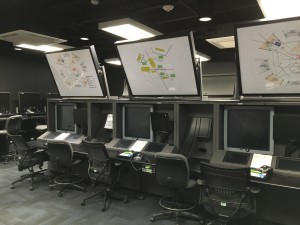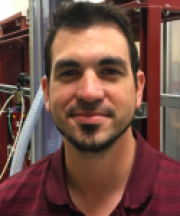Air Traffic Controller
Mentor, Gary Wescott
 Being an Air Traffic Controller is a career where young people, who can qualify, will have higher lifetime earnings than the average four-year college graduate while making a smaller investment of time and money in their education. This is especially true for young people who qualify for tuition assistance at TCC under the “Tulsa Achieves” program where all or a large part of your tuition is paid.
Being an Air Traffic Controller is a career where young people, who can qualify, will have higher lifetime earnings than the average four-year college graduate while making a smaller investment of time and money in their education. This is especially true for young people who qualify for tuition assistance at TCC under the “Tulsa Achieves” program where all or a large part of your tuition is paid.
YPNG Mentor Gary Wescott is both an experienced controller and an educator. He retired after twenty-one and a half years as an Air Traffic Controller and became an Assistant Professor for the Air Traffic Control program at Tulsa Community College. Gary didn’t know anything about being an Air Traffic Controller when he graduated from high school and took accounting and business classes in college. He learned about the FAA Air Traffic Control program from his brother when that brother left the US Air Force and began to study for the Air Traffic Control admission test. Gary decided to study with his brother and go with him for the admission test – they both became controllers within a year of each other. Gary spent most of his career as an Air Traffic Controller working at the Tulsa Riverside Airport and the Tulsa International Airport. Upon retiring he became a TCC instructor. TCC has a well-regarded, two-year Air Traffic Control program where students can receive an Associate’s degree. TCC graduates have a high success rate passing the entrance exam as well as successfully completing the course work needed to become FAA certified.
In his article, Gary talks about what it is like to be an Air Traffic Controller and how you must be able to work as a member of a team with the other controllers and pilots. He also gives some examples of the kind of stress sometimes faced trying to keep people safe and the emotions controllers feel when an accident does occur. He describes the different job opportunities available to FAA certified Air Traffic Controllers. Pay scales for these positions are well above average and are over six figures once you gain experience.
Overview
I grew up in Tahlequah, Oklahoma, a city of about 16,000 in the Northeastern part of the state. I had good grades in high school and was involved in school activities including the marching band where I was the drum major for two years. After I graduated high school, I enrolled at Northeastern State University in Tahlequah where I was an accounting and business major. I also played in their band and was chosen to be the college drum major for one year. While I was going to NSU, I worked at a convenience store near the campus and later purchased that store with my Dad. I like people and between my customers at the store, being part of the band and getting to know my college classmates I made a lot of friends. This taught me how to work well with a wide variety of people – something that helped me when I later became an Air Traffic Controller.
When I was in my third year of college, my brother left the Air Force and told me that he wanted to become an Air Traffic Controller. I never would have known about this kind of job if it weren’t for him. The FAA Academy where all U.S. controllers are certified is part of the Mike Monroney Aeronautical Center located on the grounds of the Will Rogers Airport in Oklahoma City. To be eligible to apply to become an Air Traffic Controller you need either three years of work experience, four years of college, or a combination of the two that adds up to three years. You also must pass an entrance exam, physical, psychological exam, and security background check. My brother and I got the study materials and helped each other prepare for the entrance exam, we both passed. He got accepted and graduated before I did. That let me learn a lot about what was involved in the program and what I needed to concentrate on while I was waiting for my academy date. I later went back and completed my four-year business degree after I was an Air Traffic Controller. It was a goal I had set for myself that I wanted to accomplish.
Getting Your FAA Certification
When you go to the FAA Air Traffic Control school you study for one of two specialties: Terminal Operation or En Route.
Terminal Operation – This is where the controller handles aircraft within the control zone of the airport that are departing or landing. In this role, the controller is usually working with pilots via radio keeping aircraft separated by FAA standards.
En Route – This is where the controller is responsible for airspace with defined dimensions; where aircraft are monitored with the use of radar. The job of the controller is to keep the planes separated both vertically and horizontally. Spacing is normally 1,000 feet of altitude or 5 miles vertically apart. En Route controllers require a little longer training period but have a higher pay scale than a Terminal Operator.
While you are taking FAA classes you are in a classroom with seventeen other people and are working for a grade based on a points system. The classes are hard and only about 50% graduate. But, keep in mind that some people who pass the entrance exam and are accepted have studied on their own and have not taken a program like the one at TCC. In 2014, six of the TCC graduates who completed our program went to the FAA school to become certified as Terminal controllers, all six graduated the FAA Academy. TCC also had six graduates successfully complete the En Route program that year.
There are age restrictions. You must enter the hiring process before your 31st birthday. Retirement is mandatory at age 56 but you are eligible to retire any age after working 25 years. There are also strict medical and mental requirements. Conditions like diabetes, high blood pressure and heart disease disqualify applicants as well as diagnosis of mental conditions like depression. Applicants are required to take psychological test to screen for mental disorders. Any history of drug abuse is also a disqualifier.
The number of students the FAA takes each year varies depending on how many people are retiring or leaving the profession. It can be as few as a couple of thousand to five thousand. Normally about twenty-eight thousand apply – so admission is competitive. You need to score high on your entrance exam and be able to meet the physical qualifications in order to be accepted.
My Experience as an Air Traffic Controller
I graduated the Academy as a Terminal Controller. My first duty location was Riverside Air Traffic Control Tower located at the R.L. Jones Jr. Airport in South Tulsa. The airport’s control tower is open between 7 AM to 10 PM daily. As a controller you cannot work more than 10 hours a day and cannot work more than six consecutive days without a day off. Typically you would work a forty hour work week.
During my career I also worked at Tulsa International Airport and the FAA Fort Worth Regional Office. Tulsa’s control tower is open 24/7 and requires controllers to work a variety of different shifts. Because the tower has to be manned 24/7, these various shifts can be difficult for some people and disrupt their sleep patterns.
As an Air Traffic Controller you are constantly working with a team of people, not only from your facility but also from other facilities. The controller’s at Tulsa International work with controllers from Riverside Tower, Kansas City Center, Memphis Center, Ft. Worth Center, Flight Service Stations, and of course pilots. I always enjoyed working with all these people as well as the satisfaction I got from keeping everyone who was flying safe.
However controllers face a lot of stress, especially at peak air traffic times and when weather turns bad. Most airplane accidents are caused by aircraft mechanical problems, weather, and pilot error but rarely by controller error. This is especially true for the private pilots that use Riverside compared to professional pilots. All of the accidents I have seen involved private pilots. They ranged from aircraft mechanical problems, to poor decisions by the pilots, or lack of experience by the pilot. For example, I had one pilot who insisted on taking off and using instruments when the visibility was low even though we later found out that he had only limited experience and training flying with instruments. He crashed only a few miles from the airport and both he and his passenger were killed. We also had a new pilot who had the throttle get stuck on his plane and he could not get the speed down to land. We got a mechanic on the radio and the mechanic suggested the pilot to kill the engine on approach and glide the plane to a safe landing, this was a success by the pilot still stressful for all involved. But, it is hard to handle the rare occasions when a pilot, who is someone you know, is killed especially when you see the crash. Controllers sometimes have to take a day or two off to recover from the emotional trauma. Counselors are provided when needed.
The FAA regulations have mandatory retirement for controller’s at age 56. But, you can retire at any age once you have 25 years of working air traffic. There are some administrative jobs you can get as a controller which allows you to work longer. These jobs are limited so if you decide on becoming a controller you should count on having to retire in your mid-fifties much like a policeman or fireman because of the physical requirements of the job. I was fortunate to retire early to become an Assistant Professor at TCC to teach Air Traffic Control. As much as I enjoyed my career as an Air Traffic Controller, I find it very rewarding working with young people who are pursuing the career I loved.
TCC has an excellent Air Traffic Control program and, as I have pointed out earlier, we have a high success rate for our students. TCC has just built a new, modern facility on the grounds of Riverside airport with five classrooms that have new equipment. This equipment allows the student to simulate being in a control tower and in a terminal radar environment monitoring traffic and communicating with pilots. Here are pictures of twoof our classrooms.


The Associate Degree Program is 61 hours. Below is a link to the TCC curriculum:
Take a minute to look at the classes – as you can see there is an emphasis on Math. I have found math to be very important in the pursuit of Air Traffic control. I think it is the logistics of the math and problem solving that benefits the person the most. Also multi-tasking, where you have many projects ongoing and be able to jump from one to another and never miss a beat, is a trait that best serves an Air Traffic Controller. The FAA has also identified that to make a good controller someone should have team oriented working skills. (A few examples where teamwork skills are built are sports, marching band, acting, show choirs, and debate.)
We also offer beginning pilot instruction. This is a good way for a controller to relate to some of the situations facing the pilots they are talking to every day.
TCC is a reasonably priced community college. If you are from Tulsa County you may also qualify for tuition assistance at TCC under the “Tulsa Achieves” program. For many students, this makes their tuition free. Some of the aviation training is at an additional cost.
Summary
I think that being an Air Traffic Controller is a career young people should consider if they can meet the physical and academic requirements – and can handle what, at times, can become high stress situations. Besides paying well, it is a career where you are challenged every day and where you have a lot of responsibility keeping people safe, something that has always given me a lot of satisfaction. You also get to work with interesting people in what I can best describe as a team atmosphere, something I have always enjoyed too. Although it can sometimes be stressful when there is a lot of air traffic or when weather conditions turn bad, getting your pilots and their passengers safely through these situations is one of the great personal rewards of the job.
US Bureau of Labor Statistics Compensation for an Air Traffic Controller
The median annual wage for air traffic controllers was $122,340 in May 2014. The median wage is the wage at which half the workers in an occupation earned more than that amount and half earned less. The lowest 10 percent earned less than $67,070; and the highest 10% earned more than $172,000.
The salaries for controllers increase as they complete each new training phase. According to the FAA, the starting salary for more advanced controllers who have completed on-the-job training varies with the location of the facility, the complexity of the flight paths, and other factors. A full explanation of current starting wages can be found on the FAA Aviation Careers Page.
Most air traffic controllers work full time and some work additional hours. Controllers may rotate shifts among day, evening, and night, because major control facilities operate continuously. Controllers also work weekend and holiday shifts. Less busy airports may have towers that do not operate on a 24-hour basis. Controllers at these airports have more normal work schedules.






